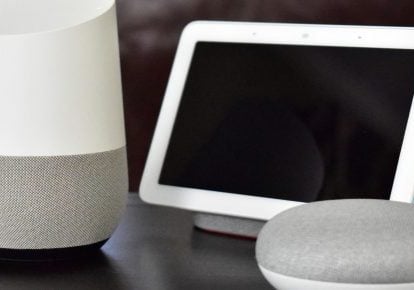
Just a few years ago, a headline like this wouldn’t have even made sense to a lot of people. But the fast-changing world of consumer electronics technology has yet again produced a whole new medium for e-commerce shopping.
In this world, e-merchants and brands have to be nimble and ready for any and every new technology if they want to keep winning the Buy Box.
Combine voice shopping with the even more recent rollout of voice-to-screen devices, in the form of smart displays like Amazon Echo Show, Google Home Hub, and Facebook Portal, and there are even more challenges ahead for e-merchants to compete for top rankings in searches.
We’ve written before about all the ways you can now shop by voice. The more conversational style of a voice query requires more fluid, comprehensive product tagging to interpret the request. That’s why we’ve had our software engineers develop an all-new product graph technology that makes it easier for Shoppingfeed’s merchants to keep a competitive advantage as more search queries are spoken, rather than typed in.
As the searches themselves transform, so must the search marketing strategies.
Voice search is on the rise, but e-commerce has been slow to keep up. Netelixir’s 2018 Search Without Screens research report found that while consumers enjoyed the hands-free convenience of voice search devices, encountering ads or branded content on their home assistant still produced some resistance.
But a lot can change in a year. According to the latest edition of NPR and Edison Research’s “Smart Audio Report” more than 60 million Americans aged 18+ owned at least one smart speaker by the end of 2019. Initial privacy concerns seem to have been cast aside.
Many consumers are still wary about placing an online order through a purely voice-activated transaction. They want to see exactly what they’re getting. Smart displays offer the best of both worlds, simplifying the shopping process while returning visual results and allowing users to make purchases with the same confidence as on their desktop or mobile devices.
Recognize how screens enhance the shopping experience.
As more and more homes are equipped with voice assistants, the move to voice-to-screen is a natural progression. Expect them to play a key role in search and retail marketing as adoption becomes more widespread. The addition of visual results to a product search inspire more confidence that they’re buying the right product, even as they continue to talk their way through the entire transaction.
An even friendlier assistant they can both see and talk to.
From a consumer’s perspective, these products provide all the convenience of a voice assistant with the tactile security and visual confirmation of a touchscreen.
Consumers are able to interact with the products they’re searching for both visually and by voice. Netelixir predicts that voice-activated assistants will see further integration with traditional screens, presenting exciting new ways for retailers to take advantage of the technology.
Design content for at-a-glance ease.
Having shoppers interacting with your content both visually and by voice requires optimizing site content for presentation on a touchscreen and by a voice assistant.
Concise keyword-forward headlines and easily digestible bullet points, for example, are a welcome sight for someone who needs to be largely hands-free while glancing at a display of product search results.
Design product listings to be context-rich.
Voice-to-screen optimization requires your PLs to be both clear and structured. Many retailers have already begun optimizing their sites for voice search, but voice-to-screen devices add another wrinkle to the process.
Think about how consumers are searching for products on these devices. They’re asking about options, features, prices, and more, with the expectation that they can hear and/or read the answers while viewing associated images on the adjacent screen.
Write relevant, quality information, for featured snippets.
Featured snippets are relevant information displayed by Google on the top of the SERP. Search engines like Google pulls the best result and displays the content in a box.
According to research, almost 30% of the search results displayed by Google comes in the form of featured snippets. Voice assistants pull their results from featured snippets wherever they can, because they are more readable. The secret to appearing in a Featured Snippet is to phrase your descriptions in a way that would answer a shopper’s full-sentence question in a voice query.
For example, a shopper query might be, “Where can I find the best selection of knife sharpeners?” Let’s say you have an online cutlery store with category pages. Your category page description could say, ‘Knives-a-Million has the best selection of knife sharpeners you will find in one place, anywhere on the web. Find dozens of different models of hand-held and electric knife sharpeners”
Because Amazon or Google search engines will be looking to answer the voiced question, their crawlers will be drawn to your store and select that snippet to feature in their answer.
Use structured data in your off-page optimization strategy.
Structured data gives you better control over how you want your website content to be returned in search results. Structured data helps your website to show up in featured snippets, and will increase your click-through rate. As your content appears in featured snippets, you will start seeing your voice search rankings rise. You can visit schema.org to understand how to implement the schema tag or structured data to your site.
Stay nimble, and always be ready for what’s next.
There’s still plenty of uncertainty surrounding the trajectory of voice search, but following best practices for each technology as it evolves–and making adjustments as needed over time–will ensure that you won’t be left behind your competitors in this brave new world.
Shoppingfeed is always looking at the next horizon. In a fast-evolving industry, you’ll quickly die otherwise. As channels evolve and new channels continue to crop up, often in whole new forms, our mission is to evolve along with them.




